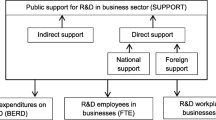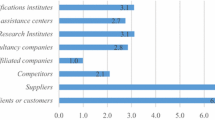Abstract
This paper analyses behavioural additionality of subsidies by regional and EU framework programme public funding granted to business enterprises in terms of the ‘instalment’ of research cooperation between industry and science. Acknowledging their specificities in terms of research orientation, research scale, and management of research, the science component is divided in universities and public research centres. Drawing on firm level data provided by the OECD bi-annual business R&D surveys of 2004 and 2006 for Belgium, the main result is that funding by regional governments fosters the instalment of industry-science research cooperation. However, this positive effect is limited to the case of cooperation with public research centres (and not with universities). The prerequisite of commercialisation of research in the case of funding by regional governments could explain this. Public funding provided by the EU framework programme did not exert an impact on the instalment of industry-science cooperation, neither with universities nor with public research centres. This could be due the fact that EU funding is targeted at firms that are already cooperating and does not favour the set-up of new cooperation.
Similar content being viewed by others
References
Aschhoff, B., Fier, A., & Fier, H. (2006). Detecting behavioural additionality: An empirical study on the impact of public R&D funding on firm’s cooperative behaviour in Germany. ZEW Discussion Paper 06-037.
Autio, E., Hameri, A. H., & Vuola, O. (2004). A framework of industrial knowledge spillovers in big-science centers. Research Policy, 33(1), 107–126.
Autio, E., Kanninen, S., & Gustafsson, R. (2008). First- and second-order additionality and learning outcomes in collaborative R&D programs. Research Policy, 37, 59–76.
Bacchiocchi, E., & Montobbio, F. (2009). Knowledge diffusion from university and public research. A comparison between US, Japan and Europe using patent citations. Journal of Technology Transfer, 34(2), 169–181.
Beise, M., & Stahl, H. (1999). Public research and industrial innovations in Germany. Research Policy, 28, 397–422.
Belderbos, R., Carree, M., Diederen, B., Lokshin, B., & Veugelers, R. (2004). Heterogeneity in R&D cooperation strategies. International Journal of Industrial Organization, 22, 1237–1263.
Bessant, J., & Rush, H. (1995). Building bridges for innovation: The role of consultants in technology transfer. Research Policy, 24, 97–114.
Boden, R., Cox, D., Georghiou, L., & Barker, K. (2001). Administrative reform of United Kingdom Government research establishments: Case studies of new organisational forms. In D. Cox, P. Gummett, & K. Barker (Eds.), Government laboratories. Transition and transformation (pp. 77–96). Amsterdam: IOS Press.
Bozeman, B. (1994). The cooperative technology paradigm: An evaluation of US government laboratories’ technology transfer activities. Policy Studies Journal, 22, 322–327.
Bruce, M., & Morris, B. (1998). In-house, outsourced or a mixed approach to design. In M. Bruce, & B. Jevnaker (Eds.), Management of design alliances: Sustaining competitive advantage (pp. 39–69). Chichester: Wiley.
Buisseret, T., Cameron, H., & Georghiou, L. (1995). What difference does it make? Additionality in the public support of R&D in large firms. International Journal of Technology Management, 10(4/5/6), 587–600.
Busom, I., & Fernandez-Ribas, A. (2004). Firm strategies in R&D: Cooperation and participation in R&D programs. Working Paper 04-05, Deparment d’Economia Applicada, Universitat Autonoma de Barcelona.
Busom, I., & Fernandez-Ribas, A. (2005). The impact of participation in R&D programs on R&D partnerships. WIFO Working Paper no 251.
Capron, H., Cincera, M., & Dumont, M. (2000). The institutional profile. In H. Capron, & W. Meeusen (Eds.), The national innovation system of Belgium (pp. 43–69). Heidelberg: Physica-Verlag.
Cassiman, B., & Veugelers, R. (2002). R&D cooperation and spillovers: Some empirical evidence from Belgium. American Economic Review, 92, 1169–1184.
CFS/STAT. (2007). www.belspo.be. Accessed December 9, 2008.
Chesbrough, H. (2003). Open innovation. The new imperative for creating and profiting from technology. Boston: Harvard Business School Press.
Clarysse, B., Wright, M., & Mustar, P. (2009). Behavioural additionality of R&D subsidies: A learning perspective. Research Policy, 38, 1517–1533.
European Commission. (2003). Third European Report on science & technology indicators, towards a knowledge-based economy. Brussels: European Commission.
European Commission. (2008). A more research-intensive and integrated European research area. Luxemburg: European Commission.
Coombs, R., & Georghiou, L. (2002). A new industrial ecology. Science, 296(5567), 471.
Dasgupta, P., & David, P. (1994). Towards a new economics of science. Research Policy, 23(5), 487–521.
Defazio, D., Lockett, A., & Wright, M. (2009). Funding incentives, collaborative dynamics and scientific productivity: Evidence from the EU framework program. Research Policy, 38(2), 293–305.
Egeln, J., Gottschalk, A., & Rammer, C. (2004). Location decisions of spin-offs from public research institutions. Industry and Innovation, 11(3), 207–223.
Falk, R. (2007). Measuring the effects of public support schemes on firms’ innovation activities: Survey evidence from Austria. Research Policy, 36(5), 665–679.
Georghiou, L. (2002). Additionality and impact of R&D subsidies. IWT Studies, 40, 57–64.
Georghiou, L., Clarysse, B., Steurs, G., Bilsen, V., & Larosse, J. (2004). Making the difference: The evaluation of behavioural additionality of R&D subsidies. IWT Studies, 48, 75.
Greene, W. H. (1996). Marginal effects in the bivariate probit model, Working Paper EC-96-11, June.
Huber, G. (1991). Organizational learning: the contributing process and the literatures. Organisation Science, 2, 88–105.
Lundvall, B. (1992). National systems of innovation. Towards a theory of innovation and interactive learning. London: Pinter Publishers.
Martin, S., & Scott, J. (2000). The nature of innovation market failure and the design of public support for private innovation. Research Policy, 29, 437–447.
Miotti, L., & Sachwald, F. (2003). Cooperative R&D: Why and with whom? An integrated framework analysis. Research Policy, 32, 1481–1499.
Mohnen, P., & Hoareau, C. (2003). What type of enterprise forges close links with universities and government labs? Evidence from CIS2. Managerial and Decision Economics, 24, 133–145.
Muldur, U., Corvers, F., Delanghe, H., Dratwa, J., Heimberger, D., Sloan, B., et al. (2006). A new deal for an effective European research policy: The design and impacts of the 7th framework programme. Dordrecht: Springer.
Nauwelaers, C. (2004). De instellingen en het beleid inzake Wetenschap, Technologie en Innovatie in België, Belgian Report on Science, Technology and Innovation. Brussels: Federal Office for Scientific, Technical and Cultural Affairs.
Nauwelaers, C. (2009). Policy mixes for r&d in Europe. A study commissioned by the European Commission, directorate general for research. Brussels: European Commission.
OECD. (2001). Innovative networks: Co-operation in national innovation systems. Paris: OECD.
OECD. (2002a). Benchmarking industry-science relations. Paris: OECD.
OECD. (2002b). Frascati manual. Paris: OECD.
OECD. (2006). Oslo manual. Paris: OECD.
Pavitt, K. (1984). Sectoral patterns for technological change: Towards a taxonomy and a theory. Research Policy, 13(6), 343–373.
Polt, W., & Psarra, F. (2006). Behavioural additionality of the EU’s 5th framework programme. In OECD (Ed.), Government R&D funding and company behaviour. Paris: OECD.
Schibany, A., & Schartinger, D. (2001). Interactions between Universities and Enterprises in Austria: An empirical analysis at the micro and sector levels. In OECD (Ed.), Innovative networks: Co-operation in national innovation systems (pp. 235–252). Paris: OECD.
Soete, L. (2007). Eindrapport: Expertgroep voor de Doorlichting van het Vlaams Innovatie-Instrumentarium. Maastricht.
Spithoven, A. (2007). Kennisproductie in België. Analyse van de O&O-Activiteiten in de Non-Profitsector. Brussel: Federaal Wetenschapsbeleid.
Tether, B. (2002). Who co-operates for innovation, and why? An empirical analysis. Research Policy, 31(6), 947–967.
Tether, B. S., & Tajar, A. (2008). Beyond industry-university links: Sourcing knowledge for innovation from consultants, private research organisations and the public science-base. Research Policy, 37(6–7), 1079–1095.
Tidd, J., Bessant, J., & Pavitt, K. (1997). Integrating technological, market and organisational change. Chichester: Wiley.
Van Helleputte, J., & Reid, A. (2004). Tackling the paradox: Can attaining global research excellence be compatible with local technology development? R&D Management, 34(1), 33–44.
Acknowledgments
The authors would like to thank an anonymous referee as well as the editor, Mike Wright, for their invaluable feedback on an earlier version of this article. This study was supported financially by the FWO Vlaanderen (project G.047.08N).
Author information
Authors and Affiliations
Corresponding author
Appendix
Rights and permissions
About this article
Cite this article
Teirlinck, P., Spithoven, A. Fostering industry-science cooperation through public funding: differences between universities and public research centres. J Technol Transf 37, 676–695 (2012). https://doi.org/10.1007/s10961-010-9205-4
Published:
Issue Date:
DOI: https://doi.org/10.1007/s10961-010-9205-4




